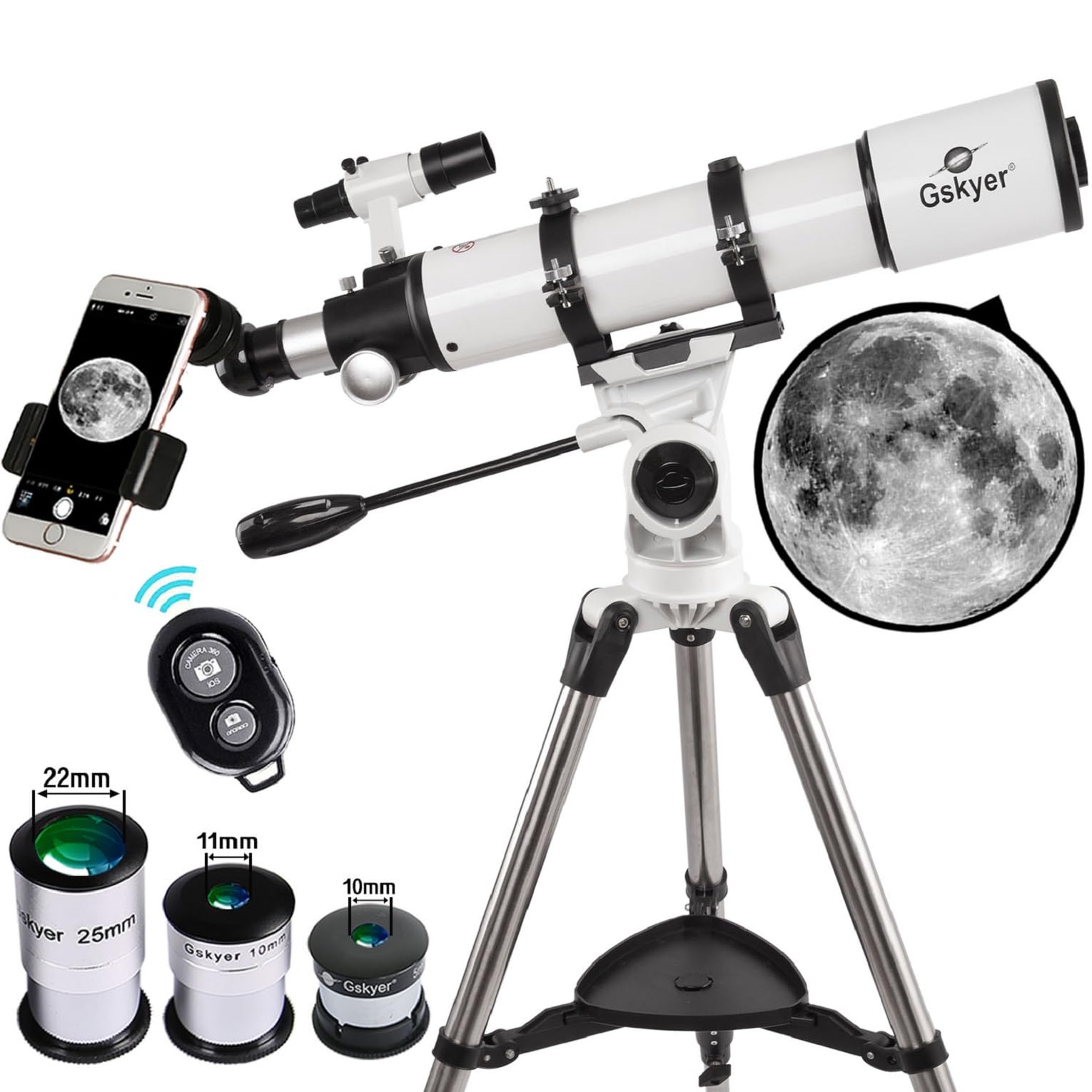Trying to find a telescope that won’t empty your wallet but still gives you a decent stargazing experience? The Gskyer 90mm telescope strikes a nice balance for beginners and casual stargazers. With a 600mm focal length and 90mm aperture, this refractor lets you catch clear views of the moon and planets—pretty satisfying for its price.
You get three eyepieces and a 3x Barlow lens, so you can play around with magnification from 24x to 120x. The adjustable aluminum tripod helps you find a comfortable spot to watch the sky. A lot of folks like how you can set it up quickly—no tools, no headache.
Of course, there are some trade-offs. The image quality works fine for the money, but don’t expect anything close to professional results. The mount sometimes feels a bit shaky, and getting the focus just right might take a little patience.
Overview of Gskyer Telescope 600x90mm AZ Astronomical Refractor Telescope
This refractor telescope really makes sense as an entry-level option for anyone just starting out. Gskyer gives you a 90mm aperture and 600mm focal length, so you’ll get clear looks at the moon and the larger planets.
You get three eyepieces, each with its own magnification. The 25mm eyepiece gives you a wide 24x view. Swap it for the 10mm and you’ll get 60x, which is nice for a closer look. The 5mm pushes things up to 120x for detailed planetary viewing.
Key Components:
- 90mm aperture for solid light gathering
- Three eyepieces plus 3x Barlow lens
- Adjustable aluminum tripod (31.5 to 49 inches)
- No tools needed for setup
This scope works nicely for moon craters and bright planets like Jupiter and Saturn. Some people find the mount gets a bit wobbly at higher magnifications. The finder scope helps you track down objects, but it might take a few tries to get the hang of aligning it.
High-Quality Optics
Gskyer’s optics deliver pretty solid performance for what you pay. The 90mm aperture pulls in enough light to show off lunar craters and the details on planets. The fully coated glass lens cuts down on glare and makes images brighter.
You’ll get crisp views of the moon’s surface, and on clear nights, Jupiter’s bands and Saturn’s rings show up. The coated optics also help protect your eyes during long viewing sessions.
The multi-coated green film knocks back reflections that can make faint objects disappear. This coating actually helps when you’re looking at dimmer stars and nebulae. The 600mm focal length strikes a nice balance between zoom and field of view.
Optical Performance at a Glance:
- Aperture: 90mm for solid light gathering
- Focal Length: 600mm (f/6.7 ratio)
- Coating: Multi-layer anti-reflection treatment
- Image Quality: Sharp lunar and planetary views
The BAK7 prism gives you correct-way-up images if you want to look at stuff on land, too. Some people notice a little color fringing around bright objects, but honestly, that’s pretty normal for this price.
Magnification Versatility
You really want the right magnification for whatever you’re checking out in the sky. The Gskyer 600x90mm comes with three eyepieces: 24x, 60x, and 120x magnification levels. That’s plenty to get started, from wide sky views to zooming in on planets.
The 3x Barlow lens included in the box triples the power of each eyepiece, so you get six different magnification choices. With it, you can hit 72x, 180x, and even 360x magnification.
Magnification Options:
- Low power: 24x for finding objects
- Medium power: 60x for general viewing
- High power: 120x for lunar details
- Extended range: Up to 360x with Barlow lens
For beginners, this variety is pretty great. You don’t have to buy extra eyepieces right away. Just keep in mind, at the highest magnifications, the 90mm aperture starts to show its limits and images can get a bit fuzzy.
Adjustable Tripod
If you want to actually enjoy a stargazing session, a comfortable setup is key. Gskyer includes an aluminum tripod that adjusts from about 31.5 inches up to 49 inches.
That height range suits both kids and adults. You can lower it for younger users or stand up to use it yourself. The aluminum construction keeps the weight manageable but still gives enough stability.
Key tripod features:
- Adjustable height: 31.5″ to 49″ range
- Aluminum construction: Lightweight yet stable
- Multiple viewing positions: Flexible setup options
The tripod connects to an altazimuth mount, so you can swing the telescope up, down, or side to side without messing with the legs every time.
A few people mention the tripod feels a little wobbly if you extend it all the way, especially if it’s windy. Honestly, that’s pretty common for entry-level scopes.
User-Friendly Operation
Getting this telescope ready to use takes just a few minutes—no tools required. The Gskyer telescope comes almost ready to go straight out of the box. Connections are simple, which is a relief if you’re new to this stuff.
The focusing system feels smooth, thanks to the easy-to-turn knob. Switching between the three eyepieces is quick, and the 3x Barlow lens pops on easily if you want to boost magnification.
Key Operation Features:
- No tools needed for assembly
- Quick focus adjustment
- Easy eyepiece switching
- Simple tripod height adjustment
The adjustable tripod lets you find a comfy viewing position, and it works for both kids and adults.
You might need to practice a bit to find objects in the sky, especially moving targets like planets. Tracking them can be tricky at first, but most people get the hang of it after a few sessions.
Durability and Build Quality
Gskyer uses a stainless steel tripod, which gives the telescope some real stability during use. Most people say the mount holds up well, though the plastic parts don’t feel as tough as the metal components.
Construction Materials:
- Stainless steel tripod legs
- Mixed plastic and metal components
- Optical glass elements with anti-reflection coating
The optical tube feels well put together for an entry-level telescope. The focuser works smoothly for most users, but a few mention it can loosen up with heavy use over time.
Accessories like the eyepieces and finder scope are basic, nothing fancy. The carrying case offers some protection, but it’s not really made for rough travel.
Overall, the build quality matches the price. It’s not going to outlast a high-end telescope, but it should handle beginner use without any big problems.
Practical Applications for Astronomy Beginners
Jumping into stargazing can feel a bit intimidating, but this Gskyer telescope keeps things manageable. The three eyepieces let you check out different celestial objects at a range of magnifications. Start with the 25mm for wide views of star clusters, then switch to the 10mm for closer looks at the moon.
This telescope works well for both the moon and planets. With higher magnification, you’ll spot Jupiter’s bands and Saturn’s rings. The 3x Barlow lens gives each eyepiece even more reach.
What works well:
- Multiple eyepieces for experimenting with views
- No tools needed for setup and focusing
- Adjustable tripod for different heights
Potential challenges:
- Higher magnifications can make objects dimmer
- Finding targets takes some practice with the finder scope
Check out the current price and availability of this Gskyer telescope on Amazon if you want to give astronomy a try.
Pros and Cons
After looking at what buyers and reviewers have to say, some clear patterns pop up about what this telescope does well and where it falls short.
Pros
Easy Setup and Use
Gskyer really nails the simple assembly. You don’t need any tools, and even kids as young as 8 can figure it out.
Good Value for Beginners
For the price, you get pretty good performance. The 90mm aperture and 600mm focal length give clear views for anyone starting out. The included eyepieces offer a bunch of magnification options.
Portable Design
The adjustable aluminum tripod makes it easy to take this scope to different spots. You can shift the height from about 31 inches to 49 inches, and most people move it around without much trouble.
Complete Package
You get everything you need to start observing right away: three eyepieces, a 3x Barlow lens, and a carrying case. The 12-month warranty gives you some peace of mind, too.
Cons
Limited Advanced Features
If you’re an experienced user, you’ll probably notice this telescope doesn’t really deliver the precision needed for serious astronomy. The mount and optics just aren’t up to the task for advanced work, especially after you’ve spent some time with it.
Focus Challenges
A handful of buyers say they struggle to get sharp focus, especially when they’re still figuring things out. Lining up the finder scope with the main telescope can be a pain, honestly.
Build Quality Issues
It works, but let’s be real—some parts just feel flimsy compared to pricier models. The plastic pieces and basic mount might not survive heavy use for very long.
Learning Curve
Even though it’s aimed at beginners, you’ll still need a bit of patience to get the setup and focusing right. There’s a learning curve, no way around it.
Ready to give the night sky a try? Check out the Gskyer telescope on Amazon to see what it’s going for right now.
Customer Reviews
Buyers have mixed feelings about how this telescope performs. A lot of parents picked it up for their kids and said it works well as a starter scope. People often mention it’s easy to set up and take apart, which is always a plus.
What buyers like:
- Assembly’s pretty simple
- Good value if you’re just starting out
- Comes with a carrying case
- Decent for checking out the moon and bright stuff
Common complaints:
- Focusing and alignment trip some folks up
- Finder scope doesn’t always line up with the main lens
- Some customers had issues with quality
Parents keep saying their kids have fun using it for stargazing. One person even said their 8-year-old could use it solo. But if you’ve never used a telescope before, you might find it tricky at first.
This telescope has a 4.2 out of 5 stars from over 21,000 reviews. Most of the negative comments come from people who wanted more advanced features.
Curious what you’ll see with it? Check current pricing and read more reviews on Amazon.
Conclusion
So, after digging into the details, I think the Gskyer telescope gives beginners a pretty good deal if you’re just starting out with stargazing. It handles the moon and bright planets decently, and a lot of parents say their kids pick it up without much trouble.
Key Strengths:
- Solid starter telescope for the price
- Setup and storage are both simple
- Includes a carrying case
- Decent for basic viewing
Main Drawbacks:
- The image quality only goes so far
- Focusing might take a little practice
- Probably not what a serious astronomer wants
If you’re just curious about stargazing or want to see if astronomy clicks for you, this telescope does the trick without draining your wallet. Kids seem to get a kick out of using it too.
Thinking about giving it a try? Check out the Gskyer telescope on Amazon for the latest price and availability.


